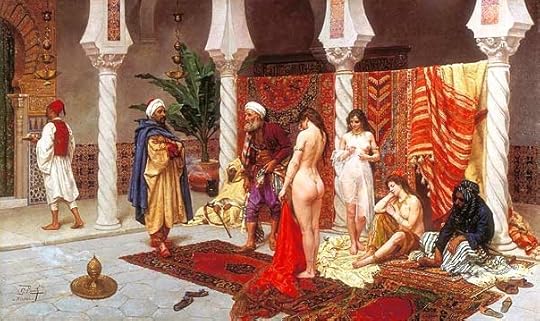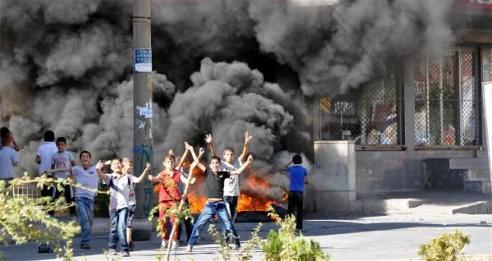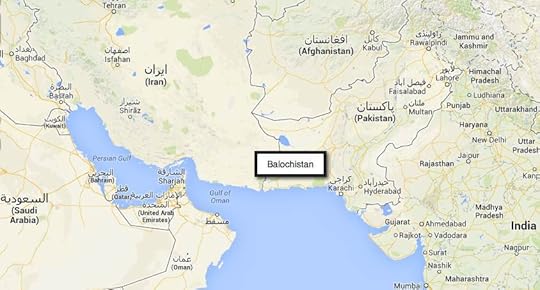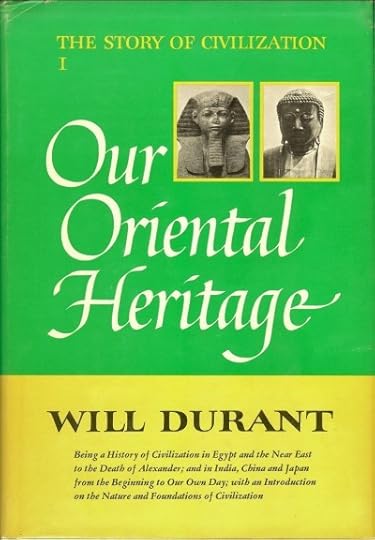Tarek Fatah's Blog, page 13
December 28, 2015
‘Indian Muslims have a Veto in Indian Politics’ – Tahir Gora interviews Tarek Fatah
December 26, 2015
Indian, U.S. and Canadian Islamic clerics justify rape of non-Muslim female POWs
Is the ‘phobia’ of Islam irrational, based on imagined fears? Or is it justified considering what Islamic clerics unashamedly speak in public forums, and that too in English, defending and justifying medieval Islamic laws that permit the rape and enslavement of non-Muslim POWs?

Artist depiction of a sex slave being sold in a middle east market
Instead of saying these laws are redundant in times of nation states that are governed by International Laws and the Geneva Conventions of War, these clerics praise Islamic sex slavery as ‘humane’ and go to the extent of attacking western civilization and culture as the real problem, not sharia-sanctioned rape and sex-slavery.
Here are three such stooges of the international Islamist movement. Notice the near unanimity of their argument. First, meet this Pakistani-American who tries to pass off as an Arab by Arabizing his name.
Abu Ammaar Yasir Qadhi from the U.S.
Then there is Zakir Naik of India…
And here is Nouman Ali Khan of Canada.
December 24, 2015
Why there is no Christmas in Kurdistan
December 24, 2015
A Pakistani journalist’s notes from Cizre in Turkey, where the Kurdish struggle for dignity is getting bloodier everyday
By Kiran Nazish
In October this year, I spent some time in the Kurdish city of Cizre in southern Turkey with families of school teachers, doctors, journalists and politicians, mostly Kurdish, but not all.
The Turkish government had just lifted a curfew and people were still reeling from the violence that had taken place in the preceding weeks.
Residents shared videos and images of their experience, as I attended funerals and meetings in neighborhoods that were seized from the ‘outsiders’, now guarded by barricades manned at times by young boys with Kalashnikovs no more than 12 years old, who guarded the streets from, what they called, ‘The Enemy State’.
The Turkish government however, calls these Kurds ‘terrorists’.
 At night, between 2:00AM to 5:00AM, there would be exchange of fire between the two sides and occasionally the Turkish military would launch rockets. The night I was leaving Cizre, one Turkish rocket landed two streets away from where I was staying.
At night, between 2:00AM to 5:00AM, there would be exchange of fire between the two sides and occasionally the Turkish military would launch rockets. The night I was leaving Cizre, one Turkish rocket landed two streets away from where I was staying.
That was in October. With sporadic breaks, November was the same, if not worse. More curfews and killings on both sides. By December, according to YDG-H (the pro PKK youth militia) over 10,000 Turkish troops had surrounded about 2,000 Kurds who have taken up arms in a struggle with the state, .
Hundreds have been killed in the fighting with the Kurdish PKK targeting Turkish security forces and Turkey’s military bombing PKK positions, cutting off towns in the south-east. Some figures note about 200,000 civilians have been displaced.
Last Monday, two protesters died in a clash between police and Kurdish demonstrators over a curfew imposed in Diyarbakir.
The city was placed under curfew in November after a pro-Kurdish lawyer, Tahir Elci was shot dead in a fight between police and unidentified gunmen. Two Turkish policemen also died in that shoot-out.
 This past week I have been getting messages from people in Cizre with whom I stayed and students I went to see in colleges and academies. Their call is desperate: “Please stop these persecutions,” “Please get our voices heard,” “Will these shootings stop, I am scared for my father who has to go to his shop everyday. We are a family of eight.”
This past week I have been getting messages from people in Cizre with whom I stayed and students I went to see in colleges and academies. Their call is desperate: “Please stop these persecutions,” “Please get our voices heard,” “Will these shootings stop, I am scared for my father who has to go to his shop everyday. We are a family of eight.”
These are young kids, some only 12, 13, 14 years old, the age of Malala Yousufzai when she was attacked by the Taliban in Pakistan. Some of these children just want to see their parents alive. And go to school, and then college and then universities, and get jobs and have a life, like any member of a civil society.
Such children don’t just live in Pakistan or Cizre, they are deprived in so many places, that we have to prioritize our investigations into such violence. Often, just covering the violence is much, much less complicated, and twisted than the Turkish-Kurds and their struggle.
https://www.dropbox.com/s/aaemjxi1qhkm3qk/Kurdish%20Uprising%20against%20Turkey.mp4?raw=1
It is a long debate, how to cover the Turkish-Kurdish conflict, how to get access, and how to make fact checking easier in places like this.
What’s not debatable is, that in places where civilians suffers at the hand of the state, and has to create its own militia for protection to stop that violence, as journalists we can’t look away.
Kiran Nazish is a Pakistani journalist, currently based in New York as a fellow at the New America Foundation.
https://www.dropbox.com/s/3gaoy7kz7thxf02/Kurdish%20Uprising%20against%20Turkey2.mp4?raw=1
December 21, 2015
The Balochistan Cauldron – Short History of a Long Conflict at the Mouth of the Persian Gulf that now involves China and soon, India

 By Muhammad Akbar Notezai
By Muhammad Akbar Notezai
The Monthly ViewPoint, Lahore
Balochistan, Pakistan’s largest and mineral rich province has been burning since 1947, at times piece by piece, at times wholesale. Problems facing Balochistan have never been addressed by any government to date. Now, when Baluchistan has its first middle-class Chief Minister, Dr. Malik Baloch, dumped bodies of “missing persons”, Hazaras’ genocide, and the exodus of Hindus and Christians goes on unabated.
When a new government was formed last summer, Prime Minister Nawaz Sharif had an opportunity to bring the dissident Baloch to the negotiating table. However, instead of visiting Balochistan, Mr. Sharif, accompanied by the Chief Minister of Balochistan ]map below], visited China with the aim of handing over Gwadar-Port and the Reko Diq project to the Chinese authorities.
As a result the Baloch people lost hope that the new government would remedy their problems. Regarding their current visit to China, Baloch believe the purpose is to exploit their resources with the collaboration of China. On the other hand Baloch nationalists say that Islamabad is not interested in the Baloch people; that they are only interested in the resources of the Baloch people. Because of this the Baloch people are alienated from Islamabad.
After coming to power, Mr. Sharif thought that he had resolved the Baloch issue when he appointed a middle-class Baloch nationalist to the position of Chief Minister of Balochistan. In doing so he failed to understand Balochistan’s on the ground realities. From the start he had the opportunity to recover the Baloch “missing’ persons” and stop the fifth military operation in the province. But he did not do so. On the contrary, atrocities against the Baloch people, including the Hazaras, have increased.
Dawn’s recent report stated that 592 “mutilated” bodies have been recovered over the past three years. Most of the dead bodies were found in Quetta, Kalat, Khuzdar and the volatile Makran belt. Most of the dead bodies are Baloch political workers.
The Governor of Balochistan, Mohammad Khan Achakzai, from the PKMAP (Pakhtun-KhwaMilliAwami Party), says he does not know if a military operation is going on in Balochistan. In the past, PKMAP opposed military operation in the province. To understand the Baloch issue, we must look at its five conflicts.
Since independence Islamabad has openly come into conflict with the Baloch insurgents five times: 1948-52, 1958-60, 1962-69, 1973-77 and 2004.
First Conflict:
On August 15, 1947, one day after Pakistan was formed, the Khan of Kalat declared Kalat’s independence. The independent status of Kalat was affirmed by the Pakistan Muslim League several times. In spite of this the “princely state” in Balochistan was invaded on April 1, 1948. The Khan’s brother, Prince Abdul Karim and his militia of 700 resisted this invasion but were crushed.
Second Conflict:
The second conflict broke out in 1958 when Islamabad merged the four provinces into “One Unit” to counter the strength of East Pakistan (which later became Bangladesh). Subsequently a large “anti-one unit” movement erupted in the Mir Ghat Mountains of Balochistan, led by the chief of the Zehri tribe, NawabNauroz Khan Zehri, along with his militia of 1000 men.
After that NawabZehri was sworn in by the army on a Quranic oath. He surrendered in May, 1959. Ultimately promises were broken and he was imprisoned along with his relatives. His relatives including his sons were hanged and he died in jail.
Third Conflict:
The third conflict began in 1962 when the central government announced their intention to establish military bases in Balochistan. Resistance to this was continued by Sher Mohammad Marri. The conflict ended with a cease fire agreement that the Balochs would be given greater autonomy.
Again promises were not kept and a fourth bloody conflict arose in 1973.
Fourth Conflict:
This conflict was triggered when Balochistan’s elected NAP (National Awami Party) government was dissolved by Zulfiqar Ali Butto. At the time, all the key Baloch leaders, including SardarAttahUllahMengal, Nawab Akbar Khan Bugti, Mir GhousBakshBizenjo and NawabKhairBakshMarri, were put behind bars.
Prime Minister Bhutto alleged that the government in Balochistan had colluded with Iraq and the Soviet Union to separate Balochistan from both Pakistan and Iran.
Pakistani authorities claimed that a cache of 300 Soviet Union sub-machine guns and 48, 000 rounds of ammunition, intended for Baloch leaders, were found in the house of the Iraqi-Defense Attaché in Islamabad. It was subsequently revealed that the arms had actually been in Karachi and were meant for Iranian Balochs in retaliation against Iran’s support to Iraqi Kurds. It was revealed that the Iraqi Defense Attaché collaborated with Iranian and Pakistan intelligence agents, staging the arms exposure to put pressure on the Iranians.
Therefore in 1973, the Shah of Iran, aided and supported Pakistan by providing US-Cobra helicopters along with pilots to shell and crush the Baloch guerillas in the Marri Mountains.
It is also to be noted that during this conflict well known socialist figures and journalists, like Asad Rehman, Mir Mohammad Ali Talpur, Dilip Das, Rashed Rehman, Ahmed Rashid and NajamSethi joined the Baloch. They fought with Baloch guerillas against the Pakistani army. Dilip Das and Najam Sethi were arrested. Sethi was released, but Dilip Das was tortured to death in a military run dungeon.
The situation normalized in 1977 when General Zia-ul-Haq in 1977 deposed Zulfiqar Ali Butto and granted general amnesty to the Baloch key leaders and their warring tribesmen.
Fifth Conflict:
The fifth and current conflict began to take shape in the late 1990s. It was spurred on in 2004 when a female physician was raped by an army officer in DeraBugti. Nawab Akbar Khan Bugti reacted strongly and demanded punishment for the rapists as the physician was in his “Bahot” (protection). No one heeded his demand. On the contrary the army shelled DeraBugti. In response Baloch guerillas fired rockets at General Parvez Musharraf’s helicopter in Kohlu, Balochistan.
This conflict was fuelled in August 26, 2006, when Nawab Bugti was assassinated in Taratani’s mountains in a military assault. His assassination tremendously changed the circumstances of Balochistan. A full army operation began in the province. The Baloch activists went missing.
Members of the provincial and national assemblies of the Balochistan National Party, headed by SardarAkhter Jan Mengal, resigned in protest against the operation and to condemn Nawab Bugti’s assassination. They held massive rallies in Balochistan against Bugti’s killing. SardarAkhterMengal was jailed. He was released when PPP (Pakistan People’s Party) came to power in 2008.
Under the Musharraf regime, BalachMarri, the son of prominent Baloch leader NawabKhairBakshMarri, was killed on 21 November 2001. The repression went on even after Gen Musharraf was deposed. Three prominent Baloch nationalists, Ghulam Mohammad Baloch (Baloch National Movement), LalaMunirBaloch (Baloch National Front) and Sher Mohammad Baloch (Baloch Republican Party) were killed. Now when Muslim League is in power, repression as usual goes on.
December 20, 2015
‘The Moslem Conquest of India’ – Will and Ariel Durant’s ‘The Story of Civilization’
Here is the text of ‘The Moslem Conquest of India’ from ‘Story of Civilization’ by Will & Ariel Durant [Volume 1, Chapter 16]
The Mohammedan Conquest of India is probably the bloodiest story in history. It is a discouraging tale, for its evident moral is that civilization is a precarious thing, whose delicate complex of order and liberty, culture and peace may at any time be overthrown by barbarians invading from without or multiplying within.
The Hindus had allowed their strength to be wasted in internal division and war; they had adopted religions like Buddhism and Jainism, which unnerved them for the tasks of life; they had failed to organize their forces for the protection of their frontiers and their capitals, their wealth and their freedom, from the hordes of Scythians, Huns, Afghans and Turks hovering about India’s boundaries and waiting for national weakness to let them in.
For four hundred years (600-1000 A.D.) India invited conquest; and at last it came. The first Moslem attack was a passing raid upon Multan, in the western Punjab (664 A.D.) Similar raids occurred at the convenience of the invaders during the next three centuries, with the result that the Moslems established themselves in the Indus valley about the same time that their Arab co-religionists in the West were fighting the battle of Tours (732 A.D.) for the mastery of Europe.
But the real Moslem conquest of India did not come till the turn of the first millennium after Christ.
In the year 997 a Turkish chieftain by the name of Mahmud became sultan of the little estate of Ghazni, in eastern Afghanistan. Mahmud knew that his throne was young and poor, and saw that India, across the border, was old and rich; the conclusion was obvious. Pretending a holy zeal for destroying Hindu idolatry, he swept across the frontier with a force inspired by a pious aspiration for booty. He met the unprepared Hindus at Bhimnagar,slaughtered them, pillaged their cities, destroyed their temples, and carried away the accumulated treasures of centuries.
Returning to Ghazni he astonished the ambassadors of foreign powers by displaying “jewels and unbored pearls and rubies shining like sparks, or like wine congealed with ice, and emeralds like fresh sprigs of myrtle, and diamonds in size and weight like pomegranates.”
Each winter Mahmud descended into India, filled his treasure chest with spoils, and amused his men with full freedom to pillage and kill; each spring he returned to his capital richer than before.
At Mathura (on the Jumna) he took from the temple its statues of gold encrusted with precious stones, and emptied its coffers of a vast quantity of gold, silver and jewellery; he expressed his admiration for the architecture of the great shrine, judged that its duplication would cost one hundred million dinars and the labour of two hundred years, and then ordered it to be soaked with naphtha and burnt to the ground. Six years later he sacked another opulent city of northern India, Somnath, killed all its fifty thousand inhabitants, and dragged its wealth to Ghazni.
In the end he became, perhaps, the richest king that history has ever known. Sometimes he spared the population of the ravaged cities, and took them home to be sold as slaves; but so great was the number of such captives that after some years no one could be found to offer more than a few shillings for a slave. Before every important engagement Mahmud knelt in prayer, and asked the blessing of God upon his arms. He reigned for a third of a century; and when he died, full of years and honours, Moslem historians ranked him as the greatest monarch of his time, and one of the greatest sovereigns of any age.
Seeing the canonization that success had brought to this magnificent thief, other Moslem rulers profited by his example, though none succeeded in bettering his instruction. .In 1186 the Ghuri, a Turkish tribe of Afghanistan, invaded India, captured the city of Delhi,destroyed its temples, confiscated its wealth, and settled down in its palaces to establish the Sultanate of Delhi- an alien despotism fastened upon northern India for three centuries, and checked only by assassination and revolt.
The first of these bloody sultans, Kutb-ud-Din Aibak, was a normal specimen of his kind -fanatical, ferocious and merciless. His gifts, as the Mohammedan historian tells us, “were bestowed by hundreds of thousands, and his slaughters likewise were by hundreds of thousands.. “In one victory of this warrior (who had been purchased as a slave), “fifty thousand men came under the collar of slavery, and the plain became black as pitch with Hindus.”
Another sultan, Balban, punished rebels and brigands by casting them under the feet of elephants, removing their skins, stuffing these with straw and hanging them from the gates of Delhi. When some Mongolian habitants who had settled in Delhi, and had been converted to Islam, attempted arising, Sultan Ala-ud-din (the conqueror of Chitor) had all the males -from fifteen to thirty thousand of them – slaughtered in one day.
Sultan Muhammad bin Tughlak acquired the throne by murdering his father, became a great scholar and an elegant writer, dabbled in mathematics, physics and Greek philosophy,surpassed his predecessors in bloodshed and brutality, fed the flesh of a rebel nephew to the rebel’s wife and children, ruined the country with reckless inflation, and laid it waste with pillage and murder till the inhabitants fled to the jungle.
He killed so many Hindus that, in the words of a Moslem historian, “there was constantly in front of his royal pavilion and his Civil Court a mound of dead bodies and a heap of corpses, while the sweepers and executioners were wearied out by their work of dragging” the victims” and putting them to death in crowds.”
In order to found a new capital at Daulatabad he drove every inhabitant from Delhi and left it a desert; and hearing that a blind man had stayed behind in Delhi, he ordered him to be dragged from the old to the new capital, so that only a leg remained of the wretch when his last journey was finished.
The Sultan complained that the people did not love him, or recognize his undeviating justice. .He ruled India for a quarter of a century, and died in bed. His successor, Firoz Shah, invaded Bengal, offered a reward for every Hindu head, paid for 180,000 of them, raided Hindu villages for slaves, and died at the ripe age of eighty. Sultan Ahmad Shah feasted for three days whenever the number of defenseless Hindus slain in his territories in one day reached twenty thousand.
These rulers were often men of ability, and their followers were gifted with fierce courage and industry; only so can we understand how they could have maintained their rule among a hostile people so overwhelmingly outnumbering them. All of them were armed with a religion militaristic in operation, but far superior in its stoical monotheism to any of the popular cults of India; they concealed its attractiveness by making the public exercise of the Hindu religions illegal, and thereby driving them more deeply into the Hindu soul.
Some of these thirsty despots had culture as well as ability; they patronized the arts, and engaged artists and artisans–usually of Hindu origin– to build for them magnificent mosques and tombs; some of them were scholars, and delighted in converse with historians, poets and scientists. One of the greatest scholars of Asia, Alberuni, accompanied Mahmud of Ghazni to India,and wrote a scientific survey of India comparable to Pliny’s “Natural History” and Humboldt’s “Cosmos”.
The Moslem historians were almost as numerous as the generals, and yielded nothing to them in the enjoyment of bloodshed and war. The Sultans drew from the people every rupee of tribute that could be exacted by the ancient art of taxation, as well as by straightforward robbery; but they stayed in India, spent their spoils in India, and thereby turned them back into India’s economic life.
Nevertheless, their terrorism and exploitation advanced that weakening of Hindu physique and morale, which had been begun by an exhausting climate, an inadequate diet, political disunity, and pessimistic religions. The usual policy of the Sultans was clearly sketched by Ala-ud-din, who required his advisers to draw up “rules and regulations for grinding down the Hindus, and for depriving them of that wealth and property which fosters disaffection and rebellion.”
Half of the gross produce of the soil was collected by the government; native rulers had taken one-sixth. “No Hindu,” says a Moslem historian, “could hold up his head, and in their houses no sign of gold or silver…or of any superfluity was to be seen…. Blows, confinement in the stocks, imprisonment and chains, were all employed to enforce payment.”
When one of his own advisers protested against this policy, Alauddin answered: “Oh,Doctor, thou art a learned man, but thou hast no experience; I am an unlettered man, but I have a great deal. Be assured, then, that the Hindus will never become submissive and obedient till they are reduced to poverty. I have therefore given orders that just sufficient shall be left to them from year to year of corn, milk and curds, but that they shall not be allowed to accumulate and property.”
This is the secret of the political history of modern India. Weakened by division, it succumbed to invaders; impoverished by invaders, it lost all power of resistance, and took refuge in supernatural consolations; it argued that both mastery and slavery were superficial delusions, and concluded that freedom of the body or the nation was hardly worth defending in so brief a life. The bitter lesson that may be drawn from this tragedy is that eternal vigilance is the price of civilization. A nation must love peace, but keep its powder dry.
Here is the extract on Scribd.com:
December 18, 2015
Everything you wanted to know about the history of Sharia Islamic Law in 10 minutes
This is part of an interview hosted by the Indian web newspaper FirstPost during my recent visit to India.
December 8, 2015
Partition of India and the forgotten question of Baluchistan – TEDxTalk by Tarek Fatah
In April 2015, I was invited by the students of India’s Rajiv Gandhi National Law University to speak at their TEDxTalk event known as TEDxRGNUL. Here is what I said to the young brilliant future lawyers of India.
While India is known to have taken birth in 1947 as a modern state, the civilisational ethos of India has survived for ages.
In this talk that was given at a TEDx event at the Rajiv Gandhi Law University in the city of Patiala in Punjab, India in March 2015, I proposed the need to develop a grand narrative of the Indian civilisation that extends beyond the geographical boundaries of the Indian Territory.
Cut off from my India is the forgotten war and the horror of the continuing conflict in Balochistan. In my chat I urged the students who hosted the TEDxRGNUL event to step forward and support the cause of Baloch nationalists and to help liberate Balochistan from the occupation of Pakistan.
.
December 4, 2015
Indian Islamic cleric blurts out his true inner contempt for India. Says Arab and Persian Muslim invaders of India are his heroes!
Watch this video to see for yourself an Islamist reveal his true ugly inner self for all of India to see on live TV. (The debate is in Hindi and Urdu languages and without sub titles.)
Watch and weep.
Maulana Ansar Raza of India has pulled the wool over Indian eyes by posturing himself as a patriotic son of India who stands firmly behind India’s secularism and is a guardian of the country’s frontiers.
His rhetoric and cliche-ridden angry statements scares non-Muslim Indians into silence, lest they be labelled as racist anti-Muslim Islamophobes, a tactic that works for most pan-Islamist Indian right wing Muslim clerics who clamour for seperate laws for Muslims in India, demand Sharia laws, and work to impose the burqa and niqab over Indian women.
But on Friday December 4, 2015, Maulana Ansar Raza didn’t have to debate Hindu Indians, but a Canadian Muslim of Indian ancestry who stated to the Islamic cleric’s face that he was dissimulating his contempt for India under camouflaged double-speak that concealed his true feelings towards Hindustan.
As I refused to let go of him and grilled him, the Islamic cleric’s outward contrived Indian patriotism fell to pieces and his true inner self was revealed.
Losing his temper, Maulana Ansar Raza blurted out in anger that he considered the Arab and Persian Islamic invaders of India from the 7th to the 11th century as his heroes. The very men who plundered and pillaged India, destroying Hindu temples and abducting tens of thousdands of Hindu girls who were later sold as sex slaves in the Arab World, as his heroes.
I asked him what he thought of the radical Islamic extremist Mogul Emperor Aurangzeb, the man who organised a genocide of Hindus, who arranged the public killing of the head of India’s Shia Dawoodi Bohra Muslims, who celebrated the torture and death of India’s assimilated Muslim Sufi saints, murdered his elder brother Prince Dara Shikoh and paraded his brother’s head through the streets of Delhi, who imprisoned to death his own father the maker of the Taj Mahal, who killed his son and sister.
True to my expectation, the Indian cleric on TV blurted out that he considered the mass murderer Mogul Emperor Aurangzeb, not just his hero, but also a ‘Wali’, an Arabic word meaning “custodian”, “protector”, “helper”. (In Islam, the phrase ولي الله walī allāh can be used to denote one vested with the “authority of God”)
With this the Indian cleric on TV had been completely stripped of his false secular camouflage and what emerged was a rabic India hater whose heroes were people who invaded India, subjugated it, and then conducted mass atrocities over India’s Hindu population, yet today blackmail the rest of India by screaming ‘intolerance’
Here is the full unedited version of the ZeeNews TV Network debate:
November 12, 2015
Watch the Video exposing ISIS War Crimes that led to Facebook shutting my account
WARNING – Graphic Violence. Video shows Islamic State ISIS jihadis torturing their Muslim POWs. Viewer discretion is advised.
https://www.dropbox.com/s/4og0g9hjrs74mxs/11255891_397784060402022_1272293953_n.mp4?raw=1
November 11, 2015
Pakistan’s Bihar and Balochistan obsession on India’s IBN7 with host Sumit Awasthi
Tarek Fatah's Blog
- Tarek Fatah's profile
- 79 followers







